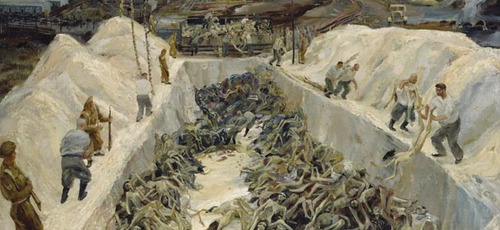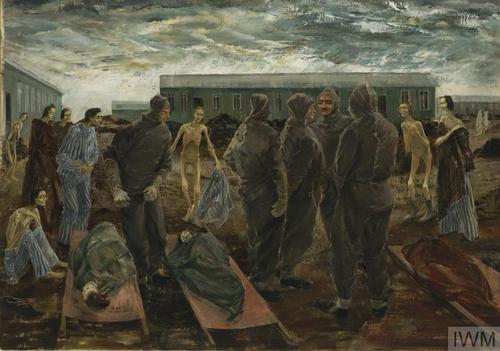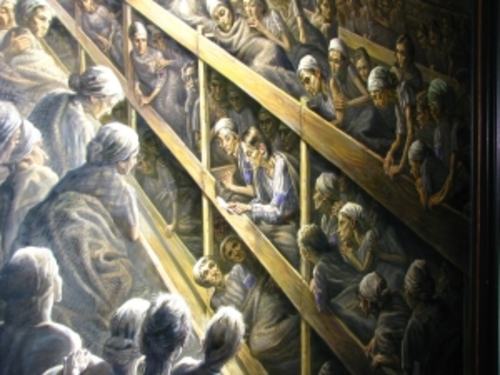Hitler's Death Camps
Bergen-Belsen
The Bergen-Belsen concentration camp is located near the village of Bergen, about 10 miles northwest of Celle, between Hannover and Hamburg in Northen Germany. It was originally used as a ‘Stalag’ during the war for holding POWs [Prisoners of War] until it was taken over by the Schutzstaffel (the SS) in 1943, who then enlarged the camp and eventually began to use it for holding a certain category of Jews, i.e., influential Jews that could be used as bargaining chips with the Allies i.e., Jews for Germans etc.
Though Bergen-Belsen had no gas chambers, many thousands of inmates who still die there, from either disease or starvation. The shortage of food was always acute, even though the camp's SS staff were all well fed. It has been said that inmates resorted to cannibalism to survive.
SS-Hauptsturmführer (Captain) Adolf Haas was the camp’s first SS commander during the spring of 1943 He would be replaced by SS-Hauptsturmführer Josef Kramer in December 1944. The number of SS functionaries in Bergen-Belsen varied over the course of the camp's existence.
Josef Kramer, would go on and earn the nickname ‘The Beast of Belsen’ because of his penchant for cruelty. Kramer had extensive experience working within the concentration camp system. He served in Mauthausen, Dachau and within the death camp at Auschwitz, where he actively took part in the gassing of some eighty female inmates. From Auschwitz, he went to Bergen-Belsen.
British troops liberated Belsen in April 1945. A reporter, Patrick Gordon described the ghastly scenes at the camp:
"I went to Belsen. It was a vast area surrounded by barbed wire. The whole thing was guarded by Hungarian guards. They had been in the German army and are now immediately serving us. They are saving us a large number of men for the time being. Outside the camp, which is amidst bushes, pines, and heather, all fairly recently planted, were great notices in red letters: DANGER-TYPHUS. Typhus broke out in the camp, and a truce was arranged so that we could take the camp over. The Germans originally had proposed that we should bypass the camp. In the meanwhile, thousands and thousands of people would have died and been shot. We refused these terms, and demanded the withdrawal of the Germans and the disarmament of the SS guards. Some dozen SS men and women were left behind under the command of Higher Sturmfurher Kramer, who had been at Auschwitz. Apparently, they had been told all sorts of fairy tales about the troops, that they could go on guarding, and that we would let them free and so forth. We only had a handful of men so far, and the SS stayed there that night. The first night of liberty, many hundreds of people died of joy. Next day some men of the Yeomanry arrived. The people crowded around them, kissing their hands and feet-and dying from weakness. Corpses in every state of decay were lying around, piled up on top of each other in heaps. There were corpses in the compound in flocks. People were falling dead all around, people who were walking skeletons. One woman came up to a soldier who was guarding the milk store and doling the milk out to children, and begged for milk for her baby. The man took the baby and saw that it had been dead for days, black in the face and shrivelled up. The woman went on begging for milk. So, he poured some on the dead lips. The mother started to croon with joy and carried her baby off in triumph. She stumbled and fell dead in a few yards. On the sixteenth, Kramer and the SS were arrested. Kramer was taken off and kept in the icebox with some stinking fish. The rest, men and women were kept under guard to save them from the inmates. The men were set to work shovelling up the corpses into lorries. Two of the men committed suicide in their cells. Two jumped off the lorry and tried to get away, they were shot down. One jumped into a concrete pool of water and was riddled with bullets. The other was brought to the ground, with a shot in the belly. The SS women were made to cook and carry heavy loads. One of them tried to commit suicide. The inmates said that they were more cruel and brutal than the men. One SS woman tried to hide, disguised as a prisoner. She was denounced and arrested.”
The most well-known holocaust victim to die in this camp was the diarist Anne Frank and her sister Margot whom both died around February 1945 of spotted typhus.
Joseph Kramer was convicted of crimes committed during his times at Auschwitz and Belsen on 17th November 1945 and was hanged on the 13th December 1945.
After Leaving Bergen Belsen, Adolf Hass took command of command of a Panzergrenadierbatallion, and was posted missing. His body was never found.
It has been estimated that between 35,000 – 40,000 prisoners died in this camp. (Source for n numbers killed: ‘The Holocaust Project. Yale University Press 2001’)
Above: Despair in Belsen
Flossenbürg
Flossenbürg concentration camp was established in May 1938 in the Neustadt district of Palatinate of Bavaria. It was originally used to house political prisoners but after the outbreak of the Second World War, it was transformed into a forced labour camp. It operated 15 subcamps but that number rose to some 80. In 1942, it was also used as a transit camp for those prisoners destined for the death camps which were located within the Generalgouvernement (rump territorial area of German occupied Poland that hadn’t been incorporated into Germany nor under the occupation from the Soviet Union).
SS-Obersturmbannführer (Lt Colonel) Karl Künstler was appointed camp commander in January 1939. Künstler was a known alcoholic and encouraged his men to rule over the prisoners with a cruel hand, He gave extra leave privileges to any of his men who killed a prisoner who was trying to escape. In September 1942, he was transferred to the Balkans and was killed in the fighting near Nuremberg as the war was coming to a close.
Egon Zill took over as camp Commandant from Künstler in 1942, but only lasted a year before he was transferred to front line duties. Zill had served as a commandant at Natzweiler. He was arrested in 1952 and given a life sentence for his crimes during his stints in the camps, but was released in 1963. he died in 1974.
In April/May 1943, Otto Max Koegel was made the camp’s commandant. Koegel was held command roles within other concentration camps such as Ravensbrück, Lichtenburg and within the death camp Majdanek. Koegel learnt his trade in the concentration camp at Dachau in 1933 served in Columbia-Haus, Sachsenhausen, Lichtenburg, Ravensbrück and within the death camp at Majdanek camp. After his arrest in 1946, Koegel committed suicide.
The prisoners were predominately used within the local granite quarry and armaments factory. At first, the camp held only German nationals but this changed on the 5th April 1940, when an influx of non-German prisoners arrived. In 1940, a medical commission visited the camp in order to select prisoners for special experiments.
In February 1943 on, inmates were forced to work in the Messerschmidt newly erected plant, which produced the Me 109 fighter aircraft.
One way that the guards used to torment their charges was by placing a metal bucket over the inmate’s head whilst being pinned down by two other guards. Several other guards, including a Kapo, would beat the bucket with clubs. The noise was amplified through the bucket, which brought the victim to a pitch of terror, when he had lost his mind and his sense of balance, the bucket was removed and he was pushed towards the wire fence. Because the inmate had lost his balance, this always him to stagger, helplessly, inside the 5-metre zone where he would be shot at from the guards within the watchtowers.
On the 9th April 1945, Admiral Wilhelm Canaris (Director of the Abwehr, the counter-intelligence Department of the German armed forces) was executed in the camp for his part in the bomb plot against Hitler in July 1944 and on 9th April 1945, Dietrich Bonhoeffer was also executed there.
As the Allies advanced, ‘Sonderhäftlinge’ – special prisoners such as Wehrmacht officers, and State officials who had been engaged in anti-Nazi resistance activities were transferred to the camp so that they could not fall into enemy hands.
Over 15,000 inmates were forced to take part in ‘death marches’ as the allied troops approached the camp. The American army liberated Flossenbürg on the 23rd April 1945. Like all the camps and ghettos, and as the war worsened for the Germans, sanitation started to break down and epidemics spread like wildfire. Many inmates died from diseases such as typhus and dysentery. Many more would die from hunger. It has been estimated that some 30,000 prisoners died within Flossenbürg (Source for numbers killed: https://www.holocaust.cz/en/history/concentration-camps-and-ghettos/flossenbuerg-2/).
Ravensbrück Concentration Camp
Ravensbrück concentration camp was establish some 56 miles north of Berlin. It was built specifically to hold female prisoners. The building of the camp began in 1938 and started to accept its first batch of prisoners in May 1939. The camp also had approximately 70 sub-camps attached to it.
SS-Standartenführer (Colonel) Günther Tamaschke (1896 –1959) became the camp's first Commandant in 1939. Other Commandants included Sturmbannführer (Major) Max Koegel (1895 – 1946) and Sturmbannführer (Major) Fritz Suhren (1908 – 1950).
In 1941, the SS established a small sub-camp for male inmates and it was prisoners from this sub-camp that built crematoria in 1943, and a gas chamber was added in 1945 that was also built just outside the camps perimeter
After the assassination of Reinhardt Heydrich in 1942, the Nazis destroyed the Czech village of Lidice as an act of revenge where all the men were murdered whilst the women and children were imprisoned within Ravensbrück.
Medical experiments were carried out on some prisoners which entailed testing new drugs and bone transplantations.
On the 25th April 1945, the camp was liberated by the Red Army.
The infamous camp guard Irma Grese did her training at Ravensbrück before being posted to Auschwitz.
Below: Ravensbrück Concentration Camp


